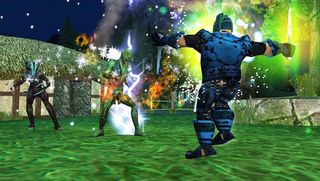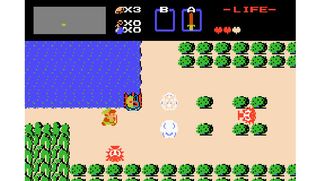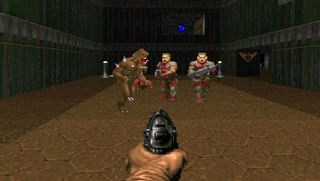The 50 most important games of all time
This is how the video game industry got to where it is today
11. Wii Sports (2006)

Scoff if you want, but before you start ranting about waggle controls, consider that Wii Sports has sold over 80 million copies. Seriously, think about that - 80 million copies. Sure, you could argue that the numbers were bolstered due to the game being a pack-in with the Wii in North America, but that's still an insane figure. Hell, we'd actually argue that most of the parents and grandparents that bought a Wii did so specifically because of Wii Sports - the console was essentially bundled with the game at that point, not the other way around.
Wii Sports launched gaming into the mainstream like no game had before. It was referenced in movies, played on talk shows, and flashed in commercials. It lowered the barrier of entry for games so that anyone could play them, while also showing off that console gaming could be accessible for everyone. And, at the same time, it was a proving point for motion gaming, which would continue to grow for the next eight years, leading to Sony creating Move, and Microsoft developing Kinect.
10. Grand Theft Auto III (2001)

Up until the release of Grand Theft Auto III in 2001, playing an open-world game mostly just meant "you can kind of go over that way a bit." But GTA III introduced us to an experience we'd never seen before: Liberty City was full of places to explore, things to do, and innocent people to beat up for cash money. You could do it all - or do nothing, if you felt so inclined; either way, fun always ensued.
While its many missions and distractions could keep you busy for hours, the simple act of driving across Liberty City's streets or causing mass panic (or using cheat codes to arm every citizen with a rocket launcher) kept us glued to our PS2s for years. Many sandbox games would eventually try to imitate GTA's success, but it remains the granddaddy of open-world thrills.
9. Half-Life (1998)

Half-Life was a trailblazer in many aspects. It moved the first-person shooter genre forward in terms of storytelling and level design, and spawned one of the most popular competitive online shooters ever. Before Half-Life, most games that had a story to tell were broken down into gameplay sections and cinematic cut scenes. Gordon Freeman's FPS adventure took video game storytelling to a new level by plopping you right in the frying pan and never taking a break. You witnessed the events of the game, including dialogue scenes, through the eyes of the silent protagonist. It was a new way to experience a story, as one of the participants rather than a spectator on the sidelines.
Storytelling accomplishments aside, Half-Life also helped popularize the competitive online gaming scene with Counter-Strike. Originally just a mod pitting bomb defusing counter-terrorists against AK-47-wielding terrorists, Counter-Strike's popularity exploded, spawning multiple game versions and updates over the last decade. The shooter is still played competitively in eSports competitions today, and many purists still stand by the balance and gameplay of the original's version 1.6.
8. Pokemon Red & Blue (1996)

Pokemon was the first video game to really achieve the same kind of child-baiting hysteria that the biggest toys and cartoons of the '80s and '90s did. The concept was simple, really: Combine cute cartoon animals with a competitive, obsessive-compulsive collecting mechanic (which could easily be transferred into merchandise designs) and you have playground gold.
Sign up to the GamesRadar+ Newsletter
Weekly digests, tales from the communities you love, and more
Years later - and with a whole multimedia empire behind it - Pokemon has proven more popular and enduring than Tamagotchis, Furbies, and Pogs combined. It has spawned a legion of imitators, all hoping for their own swig from the lightning bottle, but none ever managing to equal Nintendos achievement. And despite various missteps and commercial failings in other areas, Pokemon has kept Ninty printing money whenever it wants.
7. EverQuest (1999)

EverQuest's dangerously addictive quality was the product of brilliant design, which took the collaborative role-playing of MUDs and brought it to life in a sprawling, colorful 3D world. Players could follow the narrative of the mystical realm SOE crafted for them - or they could tell their own stories through the emergent narrative that naturally arises when you put dozens of players together.
EQ was, in essence, the proof of concept for all MMOs that followed. Yes, players do enjoy having a gear progression that mimics a carrot on a stick. Yes, it is fun to band together with a group of your peers to take on a daunting challenge. And yes, some people will play and pay for a monthly subscription fee until they've lost their jobs, homes, and families. Hey, nobody ever said progress had to be pretty.
6. The Legend of Zelda (1986)

For most home console players, gaming was incredibly straightforward: you pressed start, ran to the right, and eventually you fought a boss. So just imagine your surprise after plugging The Legend of Zelda's gold cartridge into your NES. You're dropped into a strange world and you can go in one of four directions on the map. As you walk around you see this open world is so much bigger than you imagined, and that there's adventure lurking in every corner - so long as you can find it.
The original Zelda game popularized epic quests and adventure back when few thought it was possible to build such a world within a console game. The adventure was so big Nintendo had to embrace the then-fresh concept of battery-backed saves, a novel idea that let you save your progress and return to it later. It inspired many games that followed, and not just the ones that embraced Tolkien-esque fantasy, either. You can bet that games like Grand Theft Auto and Skyrim wouldnt exist if Link hadn't bothered to pick up his sword. Mario had reopened the door for console gaming, but Zelda expanded the medium's horizons exponentially.
5. The Sims (2000)

If The Sims did one thing, it proved that game developers could get a whole lot of people addicted to a game and keep them playing for years on end thanks to expansion packs. The Sims allowed players to live out a simulated life where they could watch their Sim eat, sleep, work, and in some cases, starve to death in a house with no doors. Players created their Sims' homes, determined which relationships they had, and managed their Sim's moods. The open-ended gameplay spawned an enormous, dedicated following of players along with dozens of sequels and expansions.
Maxis' The Sims changed (or took over) many people's lives when it released back in 2000. How many people exactly? Well, more than any other game in the history of video games. When it released, the original game sold more than 16 million copies, earning itself five Guinness World records, including "World's Biggest-Selling Simulation Series", and "Best Selling PC Game of All Time." Not too shabby for a game where you can watch a little version of yourself watch TV.
4. Doom (1993)

Back in the day, they weren't called first-person shooters. They were called Doom clones. With one space marine, eight weapons, and a bucketload of demonic monsters that needed killing, Doom took the core appeals of Wolfenstein and ramped them all the way up. More gore, more atmosphere, more fun - it all merged into an intense experience that stimulated people in a way no other game had. Spraying shotgun shells, rockets, and BFG plasma at gruesome creatures in what felt like a lifelike environment was a violent, carnal delight.
To say that Doom made waves would be an understatement deserving of a revved chainsaw to the chest. The shareware found its way into every office cubicle and school computer lab across the nation. Conservatives were up in arms at the bountiful carnage and Satanic themes that saturated such a beloved game. But more than anything, Doom solidified the first-person shooting experience as a bona fide genre - the same genre that makes this industry millions of dollars each year. Were it not for id Software's bold, bloody leap forward, the modern gaming landscape would be unrecognizable.
3. Super Mario Bros. (1985)

In 1985 the video game market was nearly dead, but Nintendo (then known for arcade games and LCD handhelds called Game & Watch) wanted to save it - and it had just the killer app to do it. Bundled with the Nintendo Entertainment System, Super Mario Bros. became a cultural phenomenon, selling millions of NES consoles to the masses that couldn't resist exploring Mario's unique Mushroom Kingdom.
Aside from almost single-handedly resurrecting the home gaming market, Super Mario Bros. was also revolutionary from a design standpoint. Compared to the single screen games of the era, the scrolling world it presented seemed never-ending, and players were compelled to keep going forward to see all they possibly could. And while it's true that a couple of games before SMB featured side-scrolling gameplay, the refined controls and tight physics of Mario were genre-defining, copied by hundreds of games that followed it. Platformers stayed the dominant genre for some time, because thanks to Mario, that style encompassed video games for an entire generation of people.
2. Pong (1972)

For a game that didn't involve anything more than a moving pixel and two straight lines representing paddles, Pong sure had an incredibly powerful impact on the video game industry. By which we mean, Atari's wildly successful arcade game launched it. In the early '70s, Atari co-founder Nolan Bushnell hired a new employee by the name of Allan Alcorn and, because Alcorn had no experience in games, tasked him with developing a simple game based on table tennis as a warm-up project. That "test" became Pong, one of the most successful coin-op arcade games in history.
In fact, it was so successful that several companies began developing their own versions of Pong (itself inspired by a ping-pong game game included in the Magnavox Odyssey), which Atari tried to circumvent by developing a home console version of the game. Home Pong's success surpassed that of its arcade cousin, proving that some serious money could be made through virtual entertainment.

Sam Loveridge is the Global Editor-in-Chief of GamesRadar, and joined the team in August 2017. Sam came to GamesRadar after working at TrustedReviews, Digital Spy, and Fandom, following the completion of an MA in Journalism. In her time, she's also had appearances on The Guardian, BBC, and more. Her experience has seen her cover console and PC games, along with gaming hardware, for a decade, and for GamesRadar, she's in charge of the site's overall direction, managing the team, and making sure it's the best it can be. Her gaming passions lie with weird simulation games, big open-world RPGs, and beautifully crafted indies. She plays across all platforms, and specializes in titles like Pokemon, Assassin's Creed, The Sims, and more. Basically, she loves all games that aren't sports or fighting titles! In her spare time, Sam likes to live like Stardew Valley by cooking and baking, growing vegetables, and enjoying life in the countryside.

Assassin's Creed Shadows' Japanese setting has been "very, very tricky" because Ubisoft wants to be "respectful" and "avoid telling a culture about their own culture"
I went into Aloft expecting a Stardew Valley meets Studio Ghibli experience, but I left impressed by its whimsical take on the survival genre instead
Most Popular
